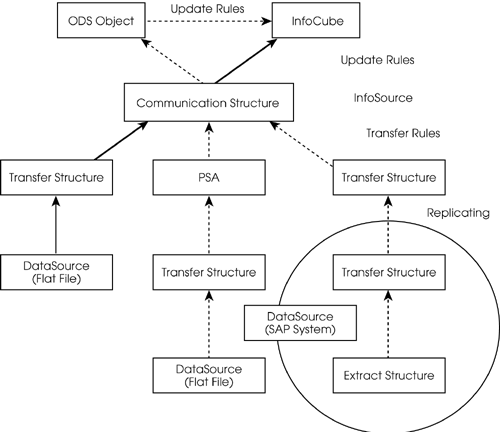Summary
In this chapter, we loaded the data described in Chapter 1 into the characteristics and InfoCube we created in Chapter 2. Figure 3.2 shows the many ways in which data can flow into a destination in BW. In this chapter, we followed the path linked via solid lines. The rest of this book will discuss the other paths.
Figure 3.2. DATA FLOW

Key Terms
| Term | Description |
|---|---|
| Source system | A source system is a protocol that enables BW to know where to find data and how to extract those data. When the source system is a non-SAP system, such as a flat file or a third-party tool, the maximum number of characters allowed for the technical name is 10. When the source system is an SAP system, either R/3 or BW, its technical name matches its logical system name. The maximum number of characters allowed for the technical name is 32. |
| Application component | Application components are used to organize InfoSources. They are analogous to the InfoAreas in InfoCubes. The maximum number of characters allowed for the technical name is 32. |
| InfoSource | An InfoSource is a structure in which InfoObjects are logically grouped together. InfoCubes and characteristics interface with InfoSources to get source system data. The maximum number of characters allowed for the technical name is 32. |
| Communication structure | The communication structure serves as the structure in the InfoSource. |
| DataSource |
A DataSource is not only a structure in which source system fields are logically grouped together, but also an object that contains ETTL-related information. Four types of DataSources exist:
The maximum number of characters allowed for the DataSources technical name is 32. |
| Transfer structure | A transfer structure maps DataSource fields to InfoSource InfoObjects. |
| Transfer rule | Transfer rules specify how DataSource fields map to InfoSource InfoObjects. |
| InfoPackage | An InfoPackage specifies when and how to load data from a given source system. BW generates a 30-digit code starting with ZPAK as an InfoPackage's technical name. |
| Update rule | An update rule specifies how data will be updated into a target. The data target can be an InfoCube or an ODS object. If the update rule is applied to data from an InfoSource, its technical name will match the InfoSource's technical name. If the update rule is applied to data from an ODS object, its technical name will match the ODS object's technical name prefixed with number 8. |
| BW Scheduler | BW Scheduler specifies when to load data. It relies on the same techniques used for scheduling R/3 background jobs. |
| BW Monitor | BW Monitor displays data load status and provides assistance in troubleshooting if errors occur. |
Next…
We will check the loaded transaction data.
Part I. Guided Tours
Business Scenario and SAP BW
- Business Scenario and SAP BW
- Sales Analysis A Business Scenario
- Basic Concept of Data Warehousing
- BW An SAP Data Warehousing Solution
- Summary
Creating an InfoCube
- Creating an InfoCube
- Creating an InfoArea
- Creating InfoObject Catalogs
- Creating InfoObjects Characteristics
- Creating InfoObjects Key Figures
- Creating an InfoCube
- Summary
Loading Data into the InfoCube
- Loading Data into the InfoCube
- Creating a Source System
- Creating an Application Component
- Creating an InfoSource for Characteristic Data
- Creating InfoPackages to Load Characteristic Data
- Checking Loaded Characteristic Data
- Entering the Master Data, Text, and Hierarchy Manually
- Creating an InfoSource for Transaction Data
- Creating Update Rules for the InfoCube
- Create an InfoPackage to Load Transaction Data
- Summary
Checking Data Quality
- Checking Data Quality
- Checking InfoCube Contents
- Using BW Monitor
- Using the Persistent Staging Area (PSA)
- Summary
Creating Queries and Workbooks
- Creating Queries and Workbooks
- Creating a Query Using BEx Analyzer
- Organizing Workbooks Using BEx Browser
- Using a Variable to Access a Hierarchy Node Directly
- Summary
Managing User Authorization
- Managing User Authorization
- Creating an Authorization Profile Using Profile Generator
- Creating an Authorization Object to Control User Access to the InfoCube Data
- Integrating Profile Generator and BEx Browser
- Summary
Part II. Advanced Topics
InfoCube Design
- InfoCube Design
- BW Star Schema
- InfoCube Design Alternative I Time-Dependent Navigational Attributes
- InfoCube Design Alternative II-Dimension Characteristics
- InfoCube Design Alternative III Time-Dependent Entire Hierarchies
- Other InfoCube Design Techniques
- Summary
Aggregates and Multi-Cubes
Operational Data Store (ODS)
- Operational Data Store (ODS)
- Creating an ODS Object
- Preparing to Load Data into the ODS Object, Then into an InfoCube
- Loading Data into the ODS Object
- Loading Data into the InfoCube
- Using 0RECORDMODE for Delta Load
- Summary
Business Content
- Business Content
- Creating an R/3 Source System
- Transferring R/3 Global Settings
- Replicating R/3 DataSources
- Installing Business Content Objects and Loading R/3 Data
- Summary
Generic R/3 Data Extraction
- Generic R/3 Data Extraction
- Creating Views in R/3
- Creating DataSources in R/3 and Replicating Them to BW
- Creating a Characteristic in BW
- Loading Data from R/3 into BW
- Summary
Data Maintenance
Performance Tuning
- Performance Tuning
- BW Statistics
- System Administration Assistant
- Tuning Query Performance
- Tuning Load Performance
- Summary
Object Transport
Appendix A. BW Implementation Methodology
Object Transport
Appendix B. SAP Basis Overview
Object Transport
- Object Transport
- Section B.1. SAP Basis 3-Tier Architecture
- Section B.2. Dispatcher, Work Processes, and Services
- Section B.3. Memory Management
Appendix C. Glossary
Appendix D. Bibliography
EAN: N/A
Pages: 106
